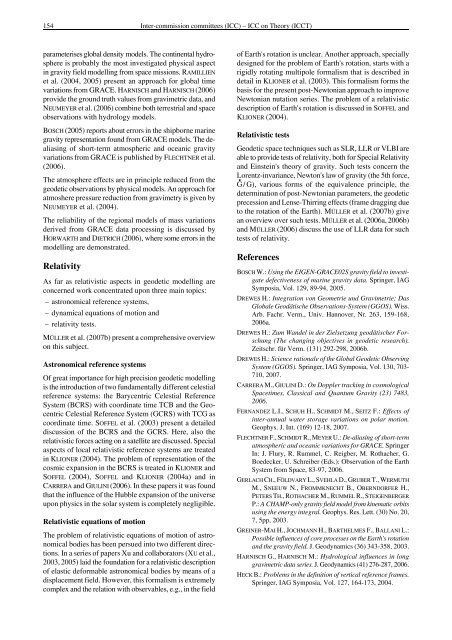NATIONAL REPORT OF THE FEDERAL REPUBLIC OF ... - IAG Office
NATIONAL REPORT OF THE FEDERAL REPUBLIC OF ... - IAG Office
NATIONAL REPORT OF THE FEDERAL REPUBLIC OF ... - IAG Office
Create successful ePaper yourself
Turn your PDF publications into a flip-book with our unique Google optimized e-Paper software.
154 Inter-commission committees (ICC) – ICC on Theory (ICCT)<br />
parameterises global density models. The continental hydrosphere<br />
is probably the most investigated physical aspect<br />
in gravity field modelling from space missions. RAMILLIEN<br />
et al. (2004, 2005) present an approach for global time<br />
variations from GRACE. HARNISCH and HARNISCH (2006)<br />
provide the ground truth values from gravimetric data, and<br />
NEUMEYER et al. (2006) combine both terrestrial and space<br />
observations with hydrology models.<br />
BOSCH (2005) reports about errors in the shipborne marine<br />
gravity representation found from GRACE models. The dealiasing<br />
of short-term atmospheric and oceanic gravity<br />
variations from GRACE is published by FLECHTNER et al.<br />
(2006).<br />
The atmosphere effects are in principle reduced from the<br />
geodetic observations by physical models. An approach for<br />
atmoshere pressure reduction from gravimetry is given by<br />
NEUMEYER et al. (2004).<br />
The reliability of the regional models of mass variations<br />
derived from GRACE data processing is discussed by<br />
HORWARTH and DIETRICH (2006), where some errors in the<br />
modelling are demonstrated.<br />
Relativity<br />
As far as relativistic aspects in geodetic modelling are<br />
concerned work concentrated upon three main topics:<br />
– astronomical reference systems,<br />
– dynamical equations of motion and<br />
– relativity tests.<br />
MÜLLER et al. (2007b) present a comprehensive overview<br />
on this subject.<br />
Astronomical reference systems<br />
Of great importance for high precision geodetic modelling<br />
is the introduction of two fundamentally different celestial<br />
reference systems: the Barycentric Celestial Reference<br />
System (BCRS) with coordinate time TCB and the Geocentric<br />
Celestial Reference System (GCRS) with TCG as<br />
coordinate time. S<strong>OF</strong>FEL et al. (2003) present a detailed<br />
discussion of the BCRS and the GCRS. Here, also the<br />
relativistic forces acting on a satellite are discussed. Special<br />
aspects of local relativistic reference systems are treated<br />
in KLIONER (2004). The problem of representation of the<br />
cosmic expansion in the BCRS is treated in KLIONER and<br />
S<strong>OF</strong>FEL (2004), S<strong>OF</strong>FEL and KLIONER (2004a) and in<br />
CARRERA and GIULINI (2006). In these papers it was found<br />
that the influence of the Hubble expansion of the universe<br />
upon physics in the solar system is completely negligible.<br />
Relativistic equations of motion<br />
The problem of relativistic equations of motion of astronomical<br />
bodies has been persued into two different directions.<br />
In a series of papers Xu and collaborators (XU et al.,<br />
2003, 2005) laid the foundation for a relativistic description<br />
of elastic deformable astronomical bodies by means of a<br />
displacement field. However, this formalism is extremely<br />
complex and the relation with observables, e.g., in the field<br />
of Earth's rotation is unclear. Another approach, specially<br />
designed for the problem of Earth's rotation, starts with a<br />
rigidly rotating multipole formalism that is described in<br />
detail in KLIONER et al. (2003). This formalism forms the<br />
basis for the present post-Newtonian approach to improve<br />
Newtonian nutation series. The problem of a relativistic<br />
description of Earth's rotation is discussed in S<strong>OF</strong>FEL and<br />
KLIONER (2004).<br />
Relativistic tests<br />
Geodetic space techniques such as SLR, LLR or VLBI are<br />
able to provide tests of relativity, both for Special Relativity<br />
and Einstein's theory of gravity. Such tests concern the<br />
Lorentz-invariance, Newton's law of gravity (the 5th force,<br />
G C / G), various forms of the equivalence principle, the<br />
determination of post-Newtonian parameters, the geodetic<br />
precession and Lense-Thirring effects (frame dragging due<br />
to the rotation of the Earth). MÜLLER et al. (2007b) give<br />
an overview over such tests. MÜLLER et al. (2006a, 2006b)<br />
and MÜLLER (2006) discuss the use of LLR data for such<br />
tests of relativity.<br />
References<br />
BOSCH W.: Using the EIGEN-GRACE02S gravity field to investigate<br />
defectiveness of marine gravity data. Springer, <strong>IAG</strong><br />
Symposia, Vol. 129, 89-94, 2005.<br />
DREWES H.: Integration von Geometrie und Gravimetrie: Das<br />
Globale Geodätische Observations-System (GGOS). Wiss.<br />
Arb. Fachr. Verm., Univ. Hannover, Nr. 263, 159-168,<br />
2006a.<br />
DREWES H.: Zum Wandel in der Zielsetzung geodätischer Forschung<br />
(The changing objectives in geodetic research).<br />
Zeitschr. für Verm. (131) 292-298, 2006b.<br />
DREWES H.: Science rationale of the Global Geodetic Observing<br />
System (GGOS). Springer, <strong>IAG</strong> Symposia, Vol. 130, 703-<br />
710, 2007.<br />
CARRERA M., GIULINI D.: On Doppler tracking in cosmological<br />
Spacetimes, Classical and Quantum Gravity (23) 7483,<br />
2006.<br />
FERNANDEZ L.I., SCHUH H., SCHMIDT M., SEITZ F.: Effects of<br />
inter-annual water storage variations on polar motion.<br />
Geophys. J. Int. (169) 12-18, 2007.<br />
FLECHTNER F., SCHMIDT R., MEYER U.: De-aliasing of short-term<br />
atmospheric and oceanic variations for GRACE. Springer<br />
In: J. Flury, R. Rummel, C. Reigber, M. Rothacher, G.<br />
Boedecker, U. Schreiber (Eds.): Observation of the Earth<br />
System from Space, 83-97, 2006.<br />
GERLACH CH., FÖLDVARY L., SVEHLA D., GRUBER T., WERMUTH<br />
M., SNEEUW N., FROMMKNECHT B., OBERNDORFER H.,<br />
PETERS TH., ROTHACHER M., RUMMEL R., STEIGENBERGER<br />
P.: A CHAMP-only gravity field model from kinematic orbits<br />
using the energy integral. Geophys. Res. Lett. (30) No. 20,<br />
7, 5pp, 2003.<br />
GREINER-MAI H., JOCHMANN H., BAR<strong>THE</strong>LMES F., BALLANI L.:<br />
Possible influences of core processes on the Earth's rotation<br />
and the gravity field. J. Geodynamics (36) 343-358, 2003.<br />
HARNISCH G., HARNISCH M.: Hydrological influences in long<br />
gravimetric data series. J. Geodynamics (41) 276-287, 2006.<br />
HECK B.: Problems in the definition of vertical reference frames.<br />
Springer, <strong>IAG</strong> Symposia, Vol. 127, 164-173, 2004.











